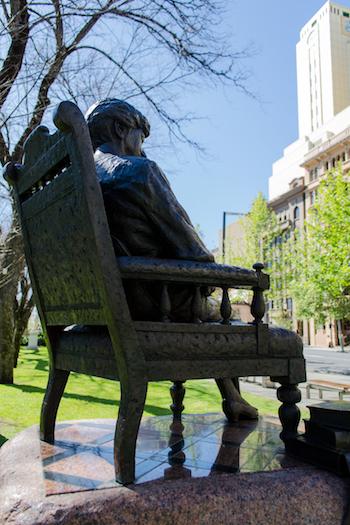Out and about on North Terrace
Duration/age

I went to visit the city one day and spied North Terrace along the way. What else do you think I spied that day?
I spied with my little eye lots of different statues – tall ones, short ones, ones with people, some with horses and one person sitting.
I spied with my little eye lots of buildings – ones to live in, some to shop in, ones to read in, some to look in, one with paintings and one with dinosaurs.
I spied with my little eye lots of signs – traffic signs, pedestrian signs, advertising signs, stop signs and shop signs.
I spied with my little eye lots of patterns – checked ones, square ones, long ones, coloured ones.
I spied with my little eye lots of plants – spiky ones, green ones, tall and leafy ones, ones to sit under, some to sit on and others to smell.
Next time you are out and about in the city take a walk along North Terrace and see how many different things you can find.
Materials you will need
- Your eyes, ears, fingers, feet and nose
Skills this activity improves
Why does this matter?
Children have a natural sense of wonder about the world around them. Stopping and talking about the things you notice as you travel helps children to make sense of what they observe. It also helps them to organise the information into meaningful patterns.
Talking together about what you have noticed on your travels helps your child to ask questions. As they notice objects they can group them and compare the differences. As they talk about what they notice they are developing language to describe their thinking and observations.
When children begin to describe their thinking they have started to hypothesise. When they hypothesise they are beginning to connect what they see to past experiences and to use this information to make decisions, reflecting on why things have happened.
What does this lead to?
Some children are naturally curious and creative, taking risks in their learning. Children who are naturally curious and creative often notice and wonder about what they see around them. They will ask questions and create their own answers. These children have a disposition to be creative and curious.
Talking about and exploring the natural and everyday environment with your child will help them to develop the skills to notice, take risks and ask questions. Even if your child does not have a natural disposition to be creative and curious, by exploring and posing questions you are helping your child to experiment with different ways of thinking.
Language to use
- Sight, view, vision, see
- Hear, sound, noise, chirp, beep, buzzing, tooting, dinging
- Long, short, round, patterned, high, tall
- Car, bike, tram, bus, truck, bus lane, bike lane, traffic
- Smell, odour, fragrance, whiff, waft, stench, stinky
- Touch, feeling, texture, rough, smooth, slippery, sharp, prickly, ouch
- Senses
- Garden, plant, flower, animal, insect, bird, people, statues, buildings
- Long, short, round, patterned
- Signs, traffic sign, pedestrian crossing, stop sign, tram stop, traffic light
- Quickly, slowly, fast
- Open, closed
- Government House, art gallery, museum, library, botanic gardens
Questions to use
- Why is there a house in the city?
- Why are there statues of people?
- Does an art gallery have books?
- Why is there a hospital in the city?
- Will we see the same things if we walk on the other side of the road?
- Do you see the same things at night as during the day?
Useful tips
- If your child is quite a bit younger just focus on one sense when you are out and about.
- If your child is younger you could make a book of things to notice before you head out.
- Sometimes it can be very scary to touch and feel new textures that appear rough or spiky.
- Remember to talk to your child in your home language.
More ideas
- Take an iPad or smartphone with you so you can plot the route you are travelling.
- Take photos of what you see and make them into an I-spy book.
- Visit the State Library, SA Museum, Art Gallery of SA or the Adelaide Botanic Garden when you are out and about.
Variation by age
Three to five year olds
- Make a list of things you have noticed when you are out and about. Sort them into what you like or don’t like.
- Take photos of your wonderings and noticings. You could use these to make cards, lotto games or memory cards.
- Make your own map of North Terrace. Mark the different things you saw along the way. Make texture dominoes.
Questions to ask
- Are there more things that you like than dislike?
- When do the trees not have leaves?
- Do all trees lose their leaves?
- What happens to the statues when it rains?
Language to use
- Route, map, direction, location, place, marker
- Like, dislike, sort, group, same, different
- Deciduous, annual, evergreen, perennial
- Weather, rain, sunshine, temperature


